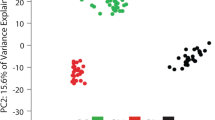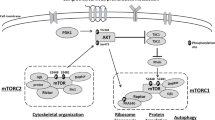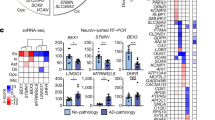Abstract
Schizophrenia is associated with alterations in working memory that reflect dysfunction of dorsolateral prefrontal cortex (DLPFC) circuitry. Working memory depends on the activity of excitatory pyramidal cells in DLPFC layer 3 and, to a lesser extent, in layer 5. Although many studies have profiled gene expression in DLPFC gray matter in schizophrenia, little is known about cell-type-specific transcript expression in these two populations of pyramidal cells. We hypothesized that interrogating gene expression, specifically in DLPFC layer 3 or 5 pyramidal cells, would reveal new and/or more robust schizophrenia-associated differences that would provide new insights into the nature of pyramidal cell dysfunction in the illness. We also sought to determine the impact of other variables, such as a diagnosis of schizoaffective disorder or medication use at the time of death, on the patterns of gene expression in pyramidal neurons. Individual pyramidal cells in DLPFC layers 3 or 5 were captured by laser microdissection from 36 subjects with schizophrenia or schizoaffective disorder and matched normal comparison subjects. The mRNA from cell collections was subjected to transcriptome profiling by microarray followed by quantitative PCR validation. Expression of genes involved in mitochondrial (MT) or ubiquitin–proteasome system (UPS) functions were markedly downregulated in the patient group (P-values for MT-related and UPS-related pathways were <10−7 and <10−5, respectively). MT-related gene alterations were more prominent in layer 3 pyramidal cells, whereas UPS-related gene alterations were more prominent in layer 5 pyramidal cells. Many of these alterations were not present, or found to a lesser degree, in samples of DLPFC gray matter from the same subjects, suggesting that they are pyramidal cell specific. Furthermore, these findings principally reflected alterations in the schizophrenia subjects were not present or present to a lesser degree in the schizoaffective disorder subjects (diagnosis of schizoaffective disorder was the most significant covariate, P<10−6) and were not attributable to factors frequently comorbid with schizophrenia. In summary, our findings reveal expression deficits in MT- and UPS-related genes specific to layer 3 and/or layer 5 pyramidal cells in the DLPFC of schizophrenia subjects. These cell type-specific transcriptome signatures are not characteristic of schizoaffective disorder, providing a potential molecular–cellular basis of differences in clinical phenotypes.
This is a preview of subscription content, access via your institution
Access options
Subscribe to this journal
Receive 12 print issues and online access
$259.00 per year
only $21.58 per issue
Buy this article
- Purchase on Springer Link
- Instant access to full article PDF
Prices may be subject to local taxes which are calculated during checkout


Similar content being viewed by others
References
Kahn RS, Keefe RS . Schizophrenia is a cognitive illness: time for a change in focus. JAMA Psychiatry 2013; 70: 1107–1112.
Goldman-Rakic PS . Cellular basis of working memory. Neuron 1995; 14: 477–485.
Arnsten AF, Wang MJ, Paspalas CD . Neuromodulation of thought: flexibilities and vulnerabilities in prefrontal cortical network synapses. Neuron 2012; 76: 223–239.
Kolluri N, Sun Z, Sampson AR, Lewis DA . Lamina-specific reductions in dendritic spine density in the prefrontal cortex of subjects with schizophrenia. Am J Psychiatry 2005; 162: 1200–1202.
Garey LJ, Ong WY, Patel TS, Kanani M, Davis A, Mortimer AM et al. Reduced dendritic spine density on cerebral cortical pyramidal neurons in schizophrenia. J Neurol Neurosurg Psychiatry 1998; 65: 446–453.
Glantz LA, Lewis DA . Decreased dendritic spine density on prefrontal cortical pyramidal neurons in schizophrenia. Arch Gen Psychiatry 2000; 57: 65–73.
Rajkowska G, Selemon LD, Goldman-Rakic PS . Neuronal and glial somal size in the prefrontal cortex: a postmortem morphometric study of schizophrenia and Huntington disease. Arch Gen Psychiatry 1998; 55: 215–224.
Pierri JN, Volk CLE, Auh S, Sampson A, Lewis DA . Decreased somal size of deep layer 3 pyramidal neurons in the prefrontal cortex of subjects with schizophrenia. Arch Gen Psychiatry 2001; 58: 466–473.
Black JE, Kodish IM, Grossman AW, Klintsova AY, Orlovskaya D, Vostrikov V et al. Pathology of layer V pyramidal neurons in the prefrontal cortex of patients with schizophrenia. Am J Psychiatry 2004; 161: 742–744.
Glausier JR, Lewis DA . Dendritic spine pathology in schizophrenia. Neuroscience 2013; 251: 90–107.
Hill JJ, Hashimoto T, Lewis DA . Molecular mechanisms contributing to dendritic spine alterations in the prefrontal cortex of subjects with schizophrenia. Mol Psychiatry 2006; 11: 557–566.
Ide M, Lewis DA . Altered cortical CDC42 signaling pathways in schizophrenia: Implications for dendritic spine deficits. Biol Psychiatry 2010; 68: 25–32.
VanLeeuwen JE, Penzes P . Long-term perturbation of spine plasticity results in distinct impairments of cognitive function. J Neurochem 2012; 123: 781–789.
Horvath S, Mirnics K . Schizophrenia as a disorder of molecular pathways. Biol Psychiatry 2015; 77: 22–28.
Perez-Santiago J, Diez-Alarcia R, Callado LF, Zhang JX, Chana G, White CH et al. A combined analysis of microarray gene expression studies of the human prefrontal cortex identifies genes implicated in schizophrenia. J Psychiatr Res 2012; 46: 1464–1474.
Arion D, Unger T, Lewis DA, Mirnics K . Molecular markers distinguishing supragranular and infragranular layers in the human prefrontal cortex. Eur J Neurosci 2007; 25: 1843–1854.
Arion D, Horvath S, Lewis DA, Mirnics K . Infragranular gene expression disturbances in the prefrontal cortex in schizophrenia: signature of altered neural development? Neurobiol Dis 2010; 37: 738–746.
Volk DW, Austin MC, Pierri JN, Sampson AR, Lewis DA . Decreased glutamic acid decarboxylase67 messenger RNA expression in a subset of prefrontal cortical gamma-aminobutyric acid neurons in subjects with schizophrenia. Arch Gen Psychiatry 2000; 57: 237–245.
Arion D, Lewis DA . Altered expression of regulators of the cortical chloride transporters NKCC1 and KCC2 in schizophrenia. Arch Gen Psychiatry 2011; 68: 21–31.
Datta D, Arion D, Lewis DA . Development of GABAA receptor subunits in layer 3 pyramidal cells of monkey prefrontal cortex. Cereb Cortex 2014 in press.
Volk DW, Matsubara T, Li S, Sengupta EJ, Georgiev D, Minabe Y et al. Deficits in transcriptional regulators of cortical parvalbumin neurons in schizophrenia. Am J Psychiatry 2012; 169: 1082–1091.
Dorph-Petersen KA, Pierri JN, Perel JM, Sun Z, Sampson AR, Lewis DA . The influence of chronic exposure to antipsychotic medications on brain size before and after tissue fixation: a comparison of haloperidol and olanzapine in macaque monkeys. Neuropsychopharm 2005; 30: 1649–1661.
Hashimoto T, Arion D, Unger T, Maldonado-Aviles JG, Morris HM, Volk DW et al. Alterations in GABA-related transcriptome in the dorsolateral prefrontal cortex of subjects with schizophrenia. Mol Psychiatry 2008; 13: 147–161.
Irizarry RA, Hobbs B, Collin F, Beazer-Barclay YD, Antonellis KJ, Scherf U et al. Exploration, normalization, and summaries of high density oligonucleotide array probe level data. Biostatistics 2003; 4: 249–264.
Gentleman RC, Carey VJ, Huber W, Irizarry RA, Dudoit S . Bioinformatics and Computational Biology Solutions Using R and Bioconductor. Springer Science+Business Media, Inc.: New York, NY, 2005.
Wang X, Lin Y, Song C, Sibille E, Tseng GC . Detecting disease-associated genes with confounding variable adjustment and the impact on genomic meta-analysis: with application to major depressive disorder. BMC Bioinformatics 2012; 13: 52.
Li J, Tseng GC . An adaptively weighted statistic for detecting differential gene expression when combing multiple transcriptomic studies. Ann Appl Stat 2011; 5: 994–1019.
Benjamini Y, Hochberg Y . Controlling the false discovery rate - a practical and powerful approach to multiple testing. J R Soc Stat Soc B Methodol 1995; 57: 289–300.
Kung L, Roberts RC . Mitochondrial pathology in human schizophrenic striatum: a postmortem ultrastructural study. Synapse 1999; 31: 67–75.
Maurer I, Zierz S, Moller H . Evidence for a mitochondrial oxidative phosphorylation defect in brains from patients with schizophrenia. Schizophr Res 2001; 48: 125–136.
Prabakaran S, Swatton JE, Ryan MM, Huffaker SJ, Huang JT, Griffin JL et al. Mitochondrial dysfunction in schizophrenia: evidence for compromised brain metabolism and oxidative stress. Mol Psychiatry 2004; 9: 643.
Iwamoto K, Bundo M, Kato T . Altered expression of mitochondria-related genes in postmortem brains of patients with bipolar disorder or schizophrenia, as revealed by large-scale DNA microarray analysis. Hum Mol Genet 2005; 14: 241–253.
Middleton FA, Mirnics K, Pierri JN, Lewis DA, Levitt P . Gene expression profiling reveals alterations of specific metabolic pathways in schizophrenia. J Neurosci 2002; 22: 2718–2729.
Vawter MP, Crook JM, Hyde TM, Kleinman JE, Weinberger DR, Becker KG et al. Microarray analysis of gene expression in the prefrontal cortex in schizophrenia: A preliminary study. Schizophr Res 2002; 58: 11–20.
Bousman CA, Chana G, Glatt SJ, Chandler SD, Lucero GR, Tatro E et al. Preliminary evidence of ubiquitin proteasome system dysregulation in schizophrenia and bipolar disorder: convergent pathway analysis findings from two independent samples. Am J Med Genet B Neuropsychiatr Genet 2010; 153B: 494–502.
Konradi C, Eaton M, MacDonald ML, Walsh J, Benes FM, Heckers S . Molecular evidence for mitochondrial dysfunction in bipolar disorder. Arch Gen Psychiatry 2004; 61: 300–308.
Vawter MP, Tomita H, Meng F, Bolstad B, Li J, Evans S et al. Mitochondrial-related gene expression changes are sensitive to agonal-pH state: implications for brain disorders. Mol Psychiatry 2006; 11: 615, 663–615, 679.
Mistry M, Gillis J, Pavlidis P . Genome-wide expression profiling of schizophrenia using a large combined cohort. Mol Psychiatry 2013; 18: 215–225.
Fillman SG, Cloonan N, Catts VS, Miller LC, Wong J, McCrossin T et al. Increased inflammatory markers identified in the dorsolateral prefrontal cortex of individuals with schizophrenia. Mol Psychiatry 2013; 18: 206–214.
Altar CA, Jurata LW, Charles V, Lemire A, Liu P, Bukhman Y et al. Deficient hippocampal neuron expression of proteasome, ubiquitin, and mitochondrial genes in multiple schizophrenia cohorts. Biol Psychiatry 2005; 58: 85–96.
Volk DW, Eggan SM, Lewis DA . Alterations in metabotropic glutamate receptor 1alpha and regulator of G protein signaling 4 in the prefrontal cortex in schizophrenia. Am J Psychiatry 2010; 167: 1489–1498.
Morris HM, Stopczynski RE, Lewis DA . NPY mRNA expression in the prefrontal cortex: selective reduction in the superficial white matter of subjects with schizoaffective disorder. Schizophr Res 2009; 115: 261–269.
Glausier JR, Kimoto S, Fish KN, Lewis DA . Lower glutamic acid decarboxylase 65 kD mRNA and protein levels in the prefrontal cortex in schizoaffective disorder but not schizophrenia. Biol Psychiatry 2014 in press.
Maldonado-Aviles JG, Curley AA, Hashimoto T, Morrow AL, Ramsey AJ, O'Donnell P et al. Altered markers of tonic inhibition in the dorsolateral prefrontal cortex of subjects with schizophrenia. Am J Psychiatry 2009; 166: 450–459.
Gruber O, Gruber E, Falkai P . Articulatory rehearsal in verbal working memory: a possible neurocognitive endophenotype that differentiates between schizophrenia and schizoaffective disorder. Neurosci Lett 2006; 405: 24–28.
Correll CU . Understanding schizoaffective disorder: from psychobiology to psychosocial functioning. J Clin Psychiatry 2010; 71: 8–13.
Li JZ, Vawter MP, Walsh DM, Tomita H, Evans SJ, Choudary PV et al. Systematic changes in gene expression in postmortem human brains associated with tissue pH and terminal medical conditions. Hum Mol Genet 2004; 13: 609–616.
Tomita H, Vawter MP, Walsh DM, Evans SJ, Choudary PV, Li J et al. Effect of agonal and postmortem factors on gene expression profile: quality control in microarray analyses of postmortem human brain. Biol Psychiatry 2004; 55: 346–352.
Sheng ZH, Cai Q . Mitochondrial transport in neurons: impact on synaptic homeostasis and neurodegeneration. Nat Rev Neurosci 2012; 13: 77–93.
Fromer M, Pocklington AJ, Kavanagh DH, Williams HJ, Dwyer S, Gormley P et al. De novo mutations in schizophrenia implicate synaptic networks. Nature 2014; 506: 179–184.
Homayoun H, Moghaddam B . NMDA receptor hypofunction produces opposite effects on prefrontal cortex interneurons and pyramidal neurons. J Neurosci 2007; 27: 11496–11500.
Lewis DA, Curley AA, Glausier JR, Volk DW . Cortical parvalbumin interneurons and cognitive dysfunction in schizophrenia. Trends Neurosci 2012; 35: 57–67.
Kern RS, Horan WP, Barch DM . On altered patterns of brain activation in at-risk adolescents and young adults. Am J Psychiatry 2013; 170: 1226–1231.
Karayiorgou M, Morris MA, Morrow B, Shprintzen RJ, Goldberg R, Borrow J et al. Schizophrenia susceptibility associated with interstitial deletions of chromosome 22q11. Proc Natl Acad Sci USA 1995; 92: 7612–7616.
Stefansson H, Rujescu D, Cichon S, Pietilainen OP, Ingason A, Steinberg S et al. Large recurrent microdeletions associated with schizophrenia. Nature 2008; 455: 232–236.
Stark KL, Xu B, Bagchi A, Lai WS, Liu H, Hsu R et al. Altered brain microRNA biogenesis contributes to phenotypic deficits in a 22q11-deletion mouse model. Nat Genet 2008; 40: 751–760.
Szatkiewicz JP, O'Dushlaine C, Chen G, Chambert K, Moran JL, Neale BM et al. Copy number variation in schizophrenia in Sweden. Mol Psychiatry 2014; 19: 762–773.
Uittenbogaard M, Baxter KK, Chiaramello A . The neurogenic basic helix-loop-helix transcription factor NeuroD6 confers tolerance to oxidative stress by triggering an antioxidant response and sustaining the mitochondrial biomass. ASN Neuro 2010; 2: e00034.
Baxter KK, Uittenbogaard M, Chiaramello A . The neurogenic basic helix-loop-helix transcription factor NeuroD6 enhances mitochondrial biogenesis and bioenergetics to confer tolerance of neuronal PC12-NeuroD6 cells to the mitochondrial stressor rotenone. Exp Cell Res 2012; 318: 2200–2214.
Uittenbogaard M, Baxter KK, Chiaramello A . NeuroD6 genomic signature bridging neuronal differentiation to survival via the molecular chaperone network. J Neurosci Res 2010; 88: 33–54.
Acknowledgements
We thank Mary L Brady, Carol Sue Johnston, Mary Ann Kelly, Kiley Laing, Amy Truong and Vishal Patel for excellent technical assistance, and Laura English for assistance in preparing the manuscript. This work was supported by a grant from Bristol-Myers Squibb and National Institutes of Health Grants MH043784, MH084053 and MH103204.
Author information
Authors and Affiliations
Corresponding author
Ethics declarations
Competing interests
DAL currently receives investigator-initiated research support from Bristol-Myers Squibb and Pfizer, and in 2012–2014 served as a consultant in the areas of target identification and validation, and new compound development to Autifony, Bristol-Myers Squibb, Concert Pharmaceuticals and Sunovion. All other authors declare no conflicts of interest.
Additional information
Supplementary Information accompanies the paper on the Molecular Psychiatry website
Supplementary information
PowerPoint slides
Rights and permissions
About this article
Cite this article
Arion, D., Corradi, J., Tang, S. et al. Distinctive transcriptome alterations of prefrontal pyramidal neurons in schizophrenia and schizoaffective disorder. Mol Psychiatry 20, 1397–1405 (2015). https://doi.org/10.1038/mp.2014.171
Received:
Revised:
Accepted:
Published:
Issue Date:
DOI: https://doi.org/10.1038/mp.2014.171
This article is cited by
-
Microglia-neuron interactions in prefrontal gray matter in schizophrenia: a postmortem ultrastructural morphometric study
European Archives of Psychiatry and Clinical Neuroscience (2023)
-
Transcriptome Analysis of the Mouse Medial Prefrontal Cortex in a Chronic Constriction Injury Model
NeuroMolecular Medicine (2023)
-
The psychiatric risk gene BRD1 modulates mitochondrial bioenergetics by transcriptional regulation
Translational Psychiatry (2022)
-
Differential vulnerability of anterior cingulate cortex cell types to diseases and drugs
Molecular Psychiatry (2022)
-
Mechanisms underlying dorsolateral prefrontal cortex contributions to cognitive dysfunction in schizophrenia
Neuropsychopharmacology (2022)



